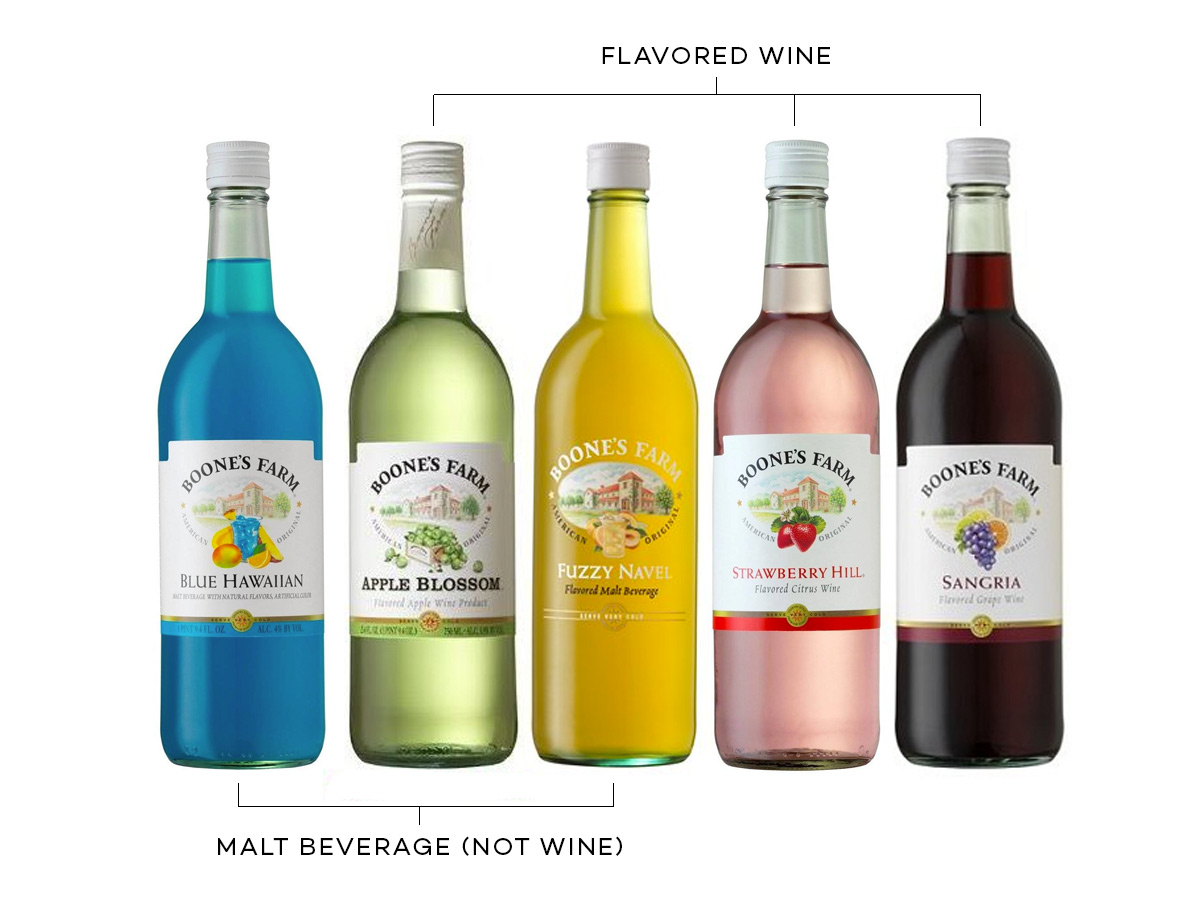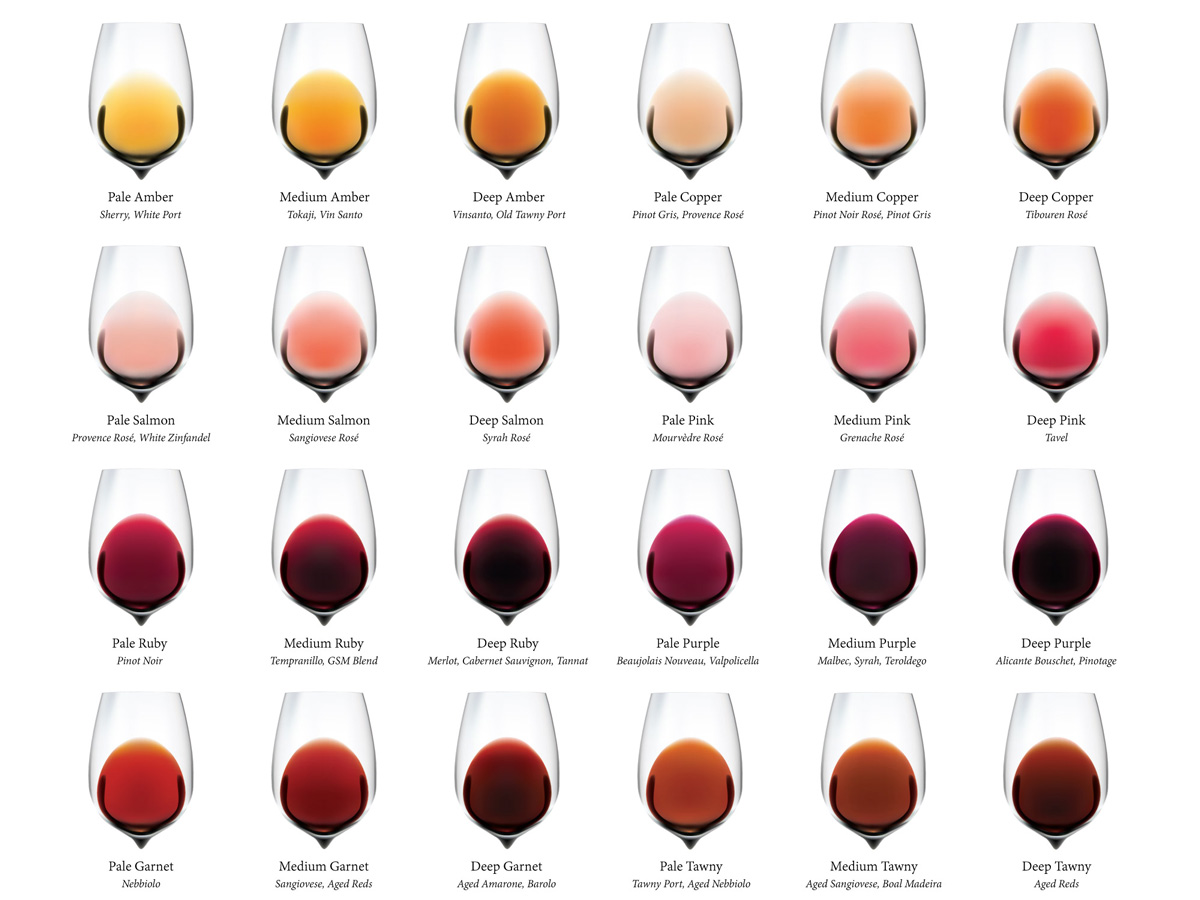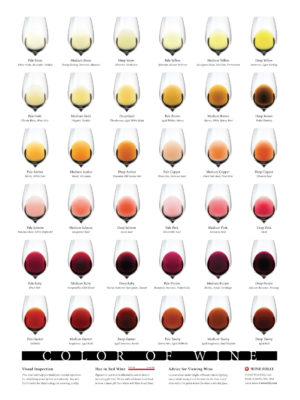Beyond the use of artificial colorings, can red and white grapes be made into wine of other colors?
We live in a colorful world. No one knows this better than Saint Patrick’s Day revelers, ready to douse green food dye in everything and anything within arms reach. Green beer? Definitely! Green eggs and ham? Gross, but of course! You could join the party and color your finest Chardonnay with a few drops of green dye #3. But beyond the use of artificial colorings, can red and white grapes be made into wine of other colors? Let’s follow the colors of the rainbow as our guide and take a deeper look.

Is it even Wine? Boone’s Farm existed during the wine cooler days, but had to change from a apple-based wine to a malt-based beverage due to a change in tax law (a law that solidified beer’s #1 position) in the industry.
RED
From Pinot Noir to Merlot, there are hundreds of dark-skinned grape varieties that, when fermented on their skins, will make wines in varying shades of red. The hue that the resulting wine exhibits depends not only on the type of grape, but also on the wine-making method, such as cold soaking and/or extended maceration. The age of a wine can also profoundly affect the color. The aging process oxidizes the pigment-containing molecules and gives red wines a more garnet, or brownish hue. And, of course we can’t forget the other, delicious, lighter end of the red color spectrum, rosé. Being made from various red-skinned grapes, rosé wines can differ in intensities of pink and salmon. They get their diverse shades and range of flavors from both the grape they are made from and the way they are made.
ORANGE
Orange wine may sound like spoiled OJ or the alcohol-laden counterpart to a pumpkin spice latte, but it is in fact, made entirely from grapes, white ones (often but not limited to, Malvasia, Rkatsiteli and Friulano). White grapes are kept in contact with their skins and seeds for an extended period of time, imparting a deep orange hue to the wine. Orange wine is more commonly found in regions such as Georgia, Slovenia, and certain parts of Italy, but many new world producers are experimenting with creating such wines, including several here in the US.
YELLOW
Vinification of white or light-skinned grapes (which are usually closer to yellowish-green in color) results in a large potential range of yellow hues, from light straw and lemon, to amber and brown tones. Again, like with red and rosé wine, the resultant color and depth of color is a product of the grape used, its ripeness at harvest, the specific wine-making method, and any post-fermentation aging or maturation (barrel or bottle). A color on the yellow/gold spectrum can also result from wine-making with red grapes, as is common practice in the making of Champagne or other sparkling wines. Here the grape must is quickly separated from the dark-colored skins preventing any pigment-containing anthocyanin compounds to color the juice. The range of colors within the white/yellow wine spectrum is vast. Some white wine grapes can also produce wines with color tints. Prime examples of green or copper tints are Grüner Veltliner and Pinot Gris, respectively.
GREEN
“Green” Wine: What pops into your mind when you hear the descriptor, “green.” Leaving Kermit the Frog at Sesame Street, the most common connotations likely involve, “organic or biodynamic,” and maybe even, “grass or weed.” Indeed, organic or biodynamic wine is nearing commonplace in today’s market. The latter are vinified from grapes grown in accordance with the cycles of the biodynamic calendar, taking the use of certified organic farming practices (criteria differ throughout the world) one step further. In spite of the hotly debated taste acumen of these “green” wines, the resultant juice still falls under the categories or red, white, and rosé.
Cannabis Wine: Herbs have been infused into wine since the time of ancient Greece. These aromatized wines are now even being infused with cannabis. One such product, Know Label, uses various strains of cannabis that are cold-extracted into the wine during vinification. The final product cannot legally be called wine, and is labeled as a “wine tincture” instead (it has 12% ABV and 3% THC). As for the color, these wines resemble standard red and white wines.
Vinho Verde: Our last hope in the quest for green wine is the popular Portuguese wine, Vinho Verde, translating directly to English as, “green wine.” Good start. Unfortunately, the quest for any color association stops there. The green in these wines refers to their slightly effervescent, fresh liveliness, as they are often low alcohol (about 9% ABV) and bottled young. They are most often made from a blend of different white grapes, such as Alvarinho, Loureiro, Azal, Arinto, and Trajadura (though single variety, red and rosé Vinho Verde wines also exist). Like other white wine varieties, there can be a slight green-tint to the light yellow hues of the white Vinho Verde wines, but not they are not fully green.
So when it comes to whether actual green-colored wine, you might need to grab a vial of green #3 to obtain the colorful result.

BLUE (INDIGO)
Feeling blue? Or maybe you’re a Smurf superfan. No matter the motivation, you’ll be happy to know that blue wine really is wine- kind of. The two main blue wines on the market today are made primarily from grapes, but both have added natural ingredients, lending to the strikingly blue color.
A Spanish company, Gik, is marketing a blue wine that is currently available for pre-order in the US, that is a striking cobalt color. It’s made from red and white grapes grown in various regions of Spain. The blue color comes from the addition of indigotin, an organic compound, and anthocyanin, the natural pigment found in grape skins. The resultant drink is sweetened with a non-caloric sweetener and can be consumed as-is or as a mixer. Interestingly, Spain allows for 17 different types of wine product classifications, but none of them account for blue-colored wine. So, even though Gik consists of mostly fermented grapes and natural dyes, it’s now in the “other alcoholic beverage” category.
Fear not in your quest for blue wine. The sparkling wine, Blanc de Bleu Cuvee Mousseux, is available in the US and is made from northern California-grown Chardonnay grapes, using the Charmat (or tank) method of production. According to the the makers, Premium Vintage Cellars, “a hint of blueberry extract is added for perfume and tender flavors,” and presumably imparts its light blue tint.
VIOLET (PURPLE)
Although there is no purple wine, per se, many dark-skinned grapes produce wines with a significant purple color, in a wide range of hues. These include Valpolicella, Malbec, Syrah, Pinotage, and Petite Sirah, to name a few. Often the violet or magenta tones are associated with a higher pH, which causes the pigment to shift from a red-base red to a blue-base red.
OTHER COLORS
In addition to our rainbow of more vibrant colors, wines can often have golden or brown hues. Garnet notes are common in red wines made from grapes such as Nebbiolo and Sangiovese. Other classic examples of wines with golden to deep brown notes are the various types of Sherry. Sherry can range in color from the light, golden Finos and Amontadillos, to deep brown wines made from the Pedro Ximenez grape. Madeira and Tawny Port, both made from a range of grape varieties, can possess similar golden to brown colors as well.
When you look closely, you’ll see that wine goes beyond the simple, common descriptors of red, white, and rosé. There are many hues, tones, and tints to wine, making the world of wine a lot more colorful than it may have originally appeared!
True Colors
You can learn a lot by assessing the color of wine. This 18×24 poster displays the true colors of wine with great accuracy and is a beautiful addition to any wine lover’s home.
Buy Poster






